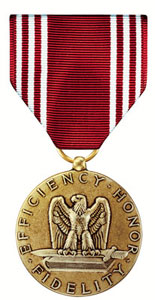Army Good Conduct Ribbon
![]()

Army Good Conduct Ribbon
![]()

Service: Army
Instituted: 1941
Criteria: Exemplary conduct, efficiency and fidelity during three years of active enlisted service with the U.S. Army (1 year during wartime)
Devices: Bronze, Silver, Gold Knotted clasp
The ribbon was designed by Arthur E. DuBois, the legendary Director of the Army Institute of Heraldry, and is scarlet with three narrow white stripes on each side. The ribbon is divided by the white stripes so as to form thirteen stripes representing the thirteen original colonies of the United States. During the Revolutionary War, the color scarlet symbolized the mother country and the white stripe symbolized the virgin land separated by force from the mother country.
Unlike other additional award devices, e.g., oak leaf clusters, bronze, silver, or gold clasps with knots (or loops) are used to indicate the total number of awards of the Army Good Conduct Medal. For instance, two awards of the medal are indicated by two bronze knots, three by three, etc. Six total awards are indicated by one silver knot, seven by two silver knots, etc. Eleven total awards are indicated by one gold knot, twelve by two gold knots, etc. While all regulations since World War II only authorize a clasp to be worn after the second award or higher; it is not unusual to see veterans with a clasp having a single bronze knot on their Army Good Conduct Medal or ribbon; this may have indicated either a single or second award and seems to have been an accepted practice.
Although the Army Good Conduct Medal was officially instituted by executive order in 1941, it really goes back to the American Revolution. When General George Washington established the Badge of Military Merit in 1782 he also created an award called the Honorary Badge of Distinction. This was the first good conduct award since it was to be conferred on veteran non-commissioned officers and soldiers of the Army who served more than three years with bravery, fidelity and good conduct. General Washington directed that the good conduct badge be made of cloth and each soldier who received it sew a narrow piece of white cloth on the left arm of his uniform jacket. Soldiers with more than six years service were to be distinguished by two pieces of cloth set parallel to each other. General Washington went on to express that this good conduct badge was a high honor and those who received it should be treated with particular confidence and consideration. However, just as the Badge of Military Merit disappeared after the Revolution so did the Honorary Badge of Distinction.
When President Roosevelt signed executive order 9323 on March 31, 1943 he officially changed the policy that the Army Good Conduct Medal could be awarded after one year. It should be understood, however, that additional awards of the Good Conduct Medal cannot be given for each additional year of service in World War II but required completion of a subsequent additional three-year period.
During the Korean War, President Eisenhower approved a first award only which could be presented for service after June 27, 1950 with less than three years, but more than one year service.
The Air Force ceased using the Army Good Conduct Medal June, 1 1963. Qualifying airmen were then awarded the Air Force Good Conduct Medal which differed from the Army Good Conduct Medal only in design of the ribbon. The medal remained the same. Personnel who earned the Army Good Conduct medal before earning the Air Force Good Conduct Medal can wear both with the Air Force Good Conduct Medal coming first.
There is often some discussion if the Army Good Conduct Medal is a decoration or service medal. Historically, going back to World War II, the Good Conduct Medal was considered a decoration and was one of a few medals to be manufactured throughout the war when service medal production was restricted due to the need to divert metal to the arms industry. Today however, it is considered a service award.
There was no certificate to denote the award of the Army Good Conduct Medal until 1981 when the Army began issuing an 8" x 10" paper certificate. The army regulations covering the issue of the paper certificate prohibited the issue of the certificate of those awarded the Good Conduct Medal prior to January 1 1981.
The Army has changed policy on official engraving of a Good Conduct Medal several times during its history. Currently the Army authorizes engraving at the government’s expense by the U.S. Army Support Activity in Philadelphia, PA.
The Good Conduct Medal is especially interesting in that it is the last United States Army award established prior to World War II. It was also the last medal that the War Department attempted to issue with a serial number (a practice dropped in WW II). It is the only United States Army medal awarded which specifically excludes officers from eligibility and is only authorized for enlisted personnel.